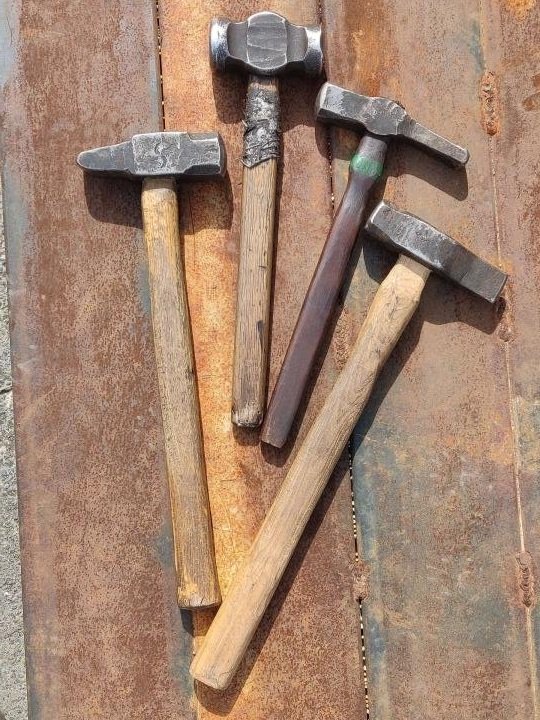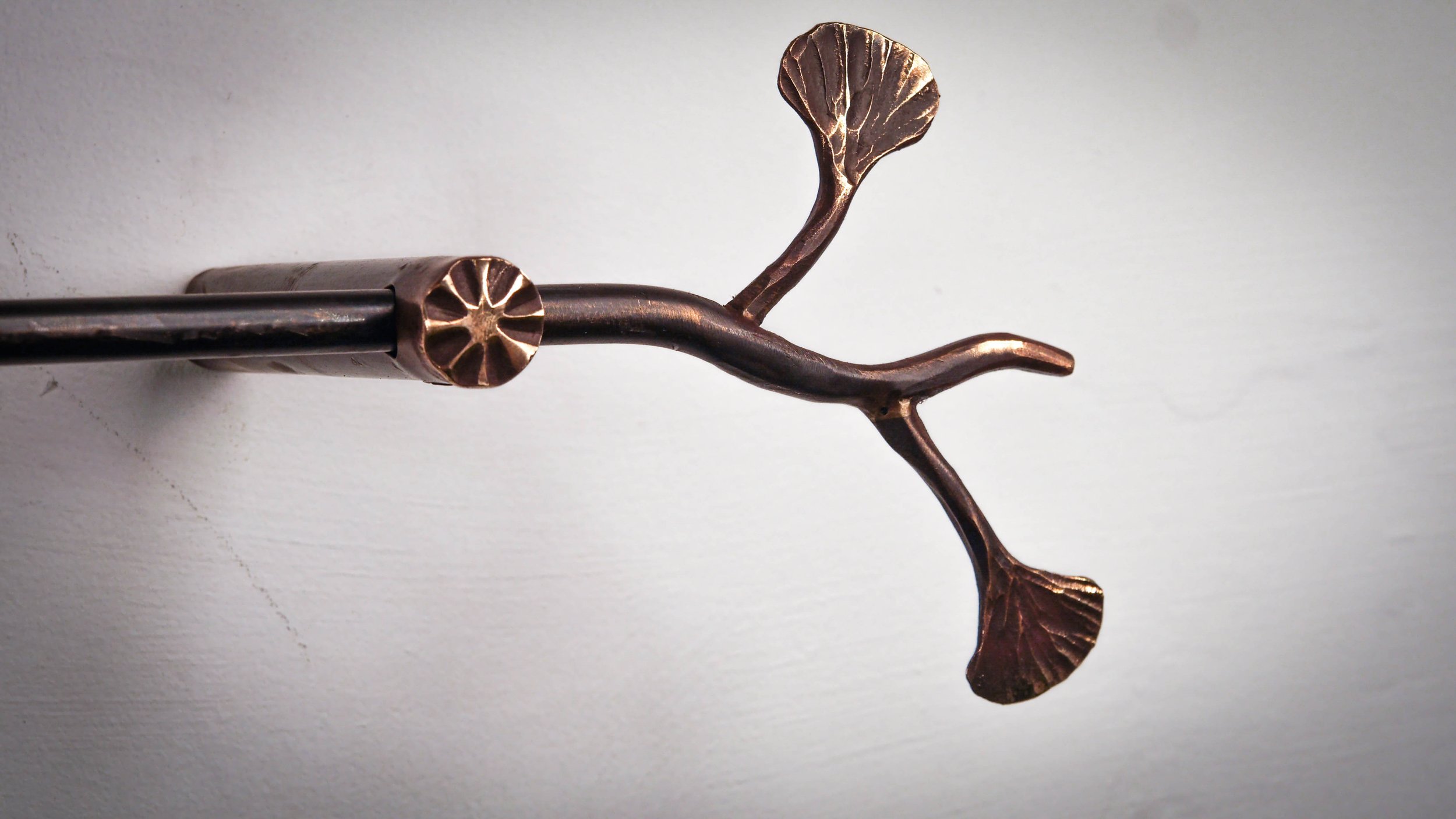How To Forge Bronze
THE LONG AWAITED GUIDE (or learn by taking a class with us)
(Pictured Above) The ultimate drinking horn holder for the dragonborn or any traveler in Skyrim. Fus Ro Dah!
Step 1: Buy the bronze!
There are three different alloys that I use. 464 Naval “bronze”, 954 aluminum bronze and 655 silicon bronze. The number is the UNS (Unified Numbering System) is the North American designations for alloys of metal. Naval bronze is usually categorized as brass but was historically considered bronze. You can read about the differences between each here:
https://www.clayandsteel.com/blog/a-guide-to-metal-options
If you are just starting out I would purchase a couple of feet of ½” or ⅜” round rod from Online Metals. Practice making leaves, hooks or whatever else you are comfortable forging.
For professional projects you can buy large quantities from Alaskan Copper and Brass, Atlas Metals, Farmers Copper or Sequoia Brass and Copper.
Step 2: Prepare Your Hammers and Your Forge
Your hammers should be smooth and unmarred. Brass and bronze are soft and they pick up small details easily. Any dings on your hammer or sanding marks will transfer to your work.
For my venturi forge I have a plate in front of the bells that can block some of the air that gets that gets mixed with the gas in my forge. By decreasing the air flow I can decrease the pressure of my propane and lower the temperature. Ideally my forge should be no hotter than 1600 degrees F.
Step 3: Heat Your Material
Naval bronze forges between 1200-1500 degrees, silicon between 1300-1600. I’m not sure about 954 aluminum, but I believe it is closer to 1300 - 1600. I don’t have a laser thermometer, so I use the luminescent colors to determine the correct temperature. For silicon bronze that might be a mid to high orange. Aluminum bronze is slightly darker and naval is no hotter than mid orange. You will have to define those temperatures based on your own senses and the lighting in your forge.
If it is too hot your bronze will melt. Check the material frequently. Sometimes the bar will melt and just a skin will remain holding the bar together. You won’t know it’s melted until you pull it out.
Naval has zinc and if it melts it will create zinc fumes. Use a fume extractor or extra ventilation and avoid breathing in fumes lest you get zinc fume fever. (Look it up, it’s very bad for you.)
Forgable Brass and Bronze Composition and Temperature Chart
| Alloy | Forgability Rating | Elemental Composition | Nominal Composition | Forging Temperatures | Anneal Temperatures |
|---|---|---|---|---|---|
| 377 Leaded Forging Brass | 100/100 | 58-61% copper, 35.7-39.7% zinc, 1.2-2.5% Lead, 0.3% iron max | 60% Cu, 39% Zn, 1% Pb | 1200-1500 degrees F | 800-1100 degrees F |
| 464 Naval Brass (Bronze) | 90/100 | 68.5-71.5% copper, 28.5-31.5% zinc, 0.05% iron, 0.07% lead | 70% Cu, 30% Zn | 1200-1520 degrees F | 800-1100 degrees F |
| 655 Silicon Bronze | 40/100 | 93-97% copper, 2.8-3.8% silicon, 0.5-1.3% manganese, 0.8% iron, 0.05% lead, up to 1.5% zinc | 95% Cu, 3% Si, 1% Mg, 1% Fe | 1300-1600 degrees F | 900-1300 degrees F |
| 954 Aluminum Bronze | 70/100 | 83% copper, 3-5% iron, 1.5% nickel, 10-11.5% aluminum, 0.5% manganese | 85% Cu, 11% Al, 4% Fe | Estimated 1300-1600 degrees F | 1150-1225 degrees F |
Step 4: Hammer Time!
You can forge your bronze with the same techniques you use for steel. Be aware that it is much softer. This can make forging easier or harder depending on your abilities. It takes less force to move but requires very precise control. There is less room for error because every mark you make is clearly visible.
Be aware as your material begins to lose luminescence. If it is too cold it can become brittle and break.
What is even more common than breakage because of insufficient heat is breakage due to a differential in temperature. Pretend you are making a leaf. You have a large mass on the end of your rod to make the leaf and a skinny neck for the stem. Pretend you heat your material evenly in the forge. You begin hammering out your leaf while leaving the stem untouched. As the stem cools in the air and your leaf remains hot you will get a big difference in temperature. The hot leaf will be extra soft and malleable and the cool stem becomes hard and brittle. This difference in properties will cause the leaf and stem to break apart.
Step 5: CONTROL YOUR HEAT!
This is probably the hardest part of forging bronze. You need to make sure you heat the material enough that it is forgable, without melting any part of it and without cooling off any one part too much.
Let's think about this leaf again. The tip of my leaf has a lot of surface area and will heat up quickly in the forge. I will sit my stem by the door of my forge so it won’t heat up as quickly. I will get enough heat on my stem that it won’t break but it won’t get so hot that it melts.
I still have a problem. The mass in the center of my leaf won’t get hot enough without the tip of the leaf melting off. I need to quench the tip of my leaf in my quench bucket repeatedly as it is heating up so it doesn’t melt. This can be agonizing and tedious for some people, but once you get used to controlling the heat you will have no problems forging bronze.
Never leave your material in the fire to answer the phone or talk to a colleague. And good luck trying to forge more than one piece at a time, I’ve never managed it.
A couple more ways to control your heat. 1. Use a torch! If you have an oxy acetelyne or oxy propane set up you can absolute use a torch for isolated heat. The person I learned from, Jerry Coe, uses a torch almost exclusively for forging small parts. 2. Use a solid fuel forge. I don’t use coke or coal myself so I can’t comment on the process. If you are good at controlling your heat you can absolutely use a solid fuel forge for bronze. Just make sure your heat isn’t too isolated. 3. Someone made the suggestion to use clay to keep the small areas from overheating. I have found this method to be time consuming and ineffective. The clay takes time to dry after every application, and it falls off when you forge it. I have found that this process takes extra time and effort, but it might be worth some experiments. If you do find a way to make this method useful, I’d love to hear about it.
Step 6: Finish
Finishing is a unique process and deserves its own blog post.
Feel free to quench your finished piece in water. Bronze is a copper alloy. It does not have a cubic structure like steel. You can anneal bronze by heating it to luminescence. Quenching bronze in water does not harden it. It can be hardened by hammering. You can carefully hammer the surface at a colder temperature to harden it. If you heat it again it will become soft.
If you have questions about forging, please ask and I may add the answer to this blog post. If you’re interested in a blog post about finishing please sign up for my email list or follow me on social media.
Final Thoughts
I will be updating this guide regularly, due to it’s top placement on google now. If you found this helpful, consider purchasing a sticker or a t-shirt to keep my business alive and my forges lit.
Put this on your propane tank or welder please. Other acceptable places to be determined by buyer.
There are lots of colors this time





